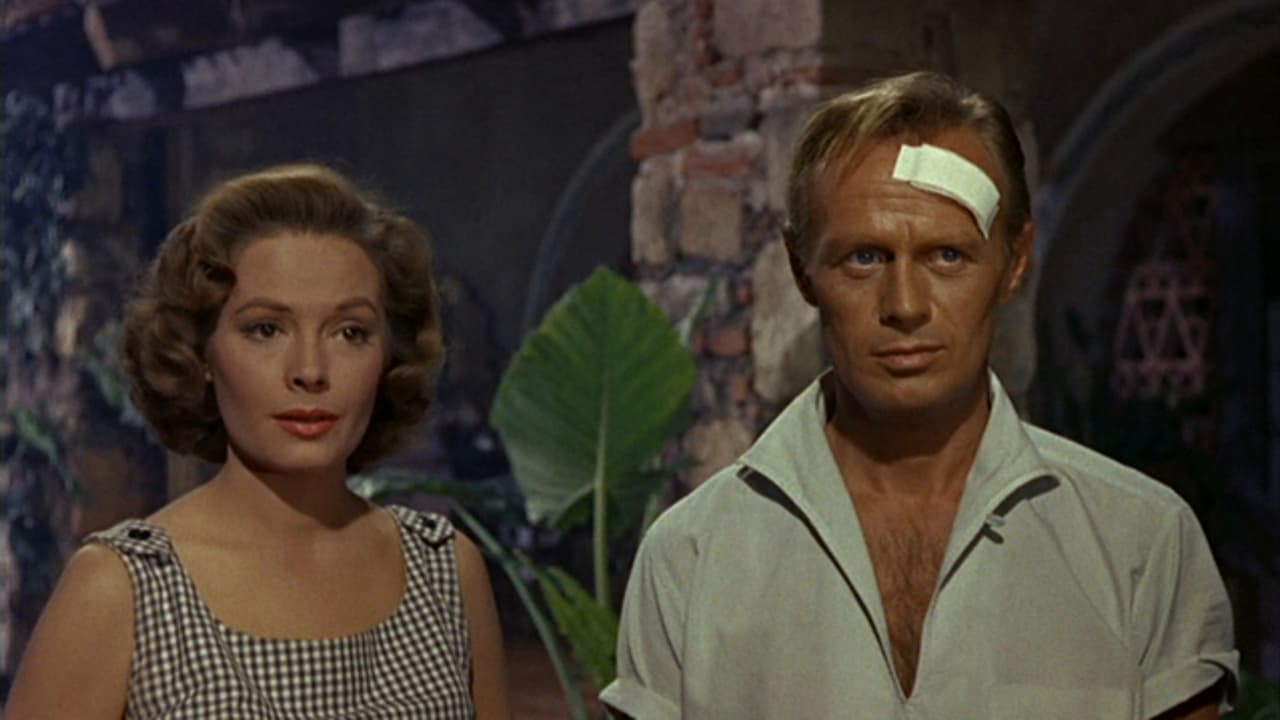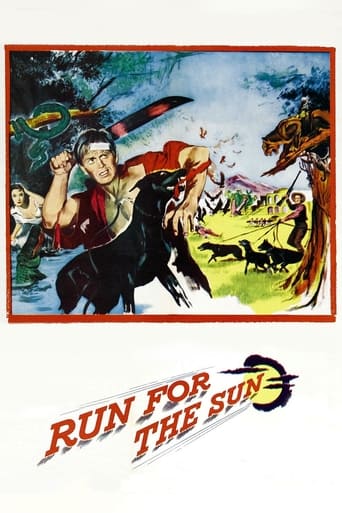

Waste of time
... View MoreTells a fascinating and unsettling true story, and does so well, without pretending to have all the answers.
... View MoreThe movie is wonderful and true, an act of love in all its contradictions and complexity
... View MoreA terrific literary drama and character piece that shows how the process of creating art can be seen differently by those doing it and those looking at it from the outside.
... View MoreExciting and suspenseful reworking of "The Most Dangerous Game" has Richard Widmark as a reclusive Hemingway-like writer living in Mexico and Jane Greer as a magazine reporter trying to find out why he stopped writing. Two find themselves stranded in the jungle after their plane crashes. They happen upon a remote compound with some friendly European gentlemen, except that these gentlemen really aren't so friendly and SPOILER ALERT! are Nazi and Russian war criminals who then want to hunt Widmark and Greer for sport. Tone can be difficult with these human-hunting-human stories, where it can easily become ridiculous (i.e. "Hart Target"), but this film gets it right and I'll credit the smart script co-written by Dudley Nichols, who wrote everything from "Bringing Up Baby" to "Stagecoach." The story moves along at a good clip, with Widmark growing increasingly suspicious of his hosts, and has some solid action and suspense once the hunt begins. FUN FACT: According to IMDB, Richard Widmark thought this was one of his worst films and used to tell his kids that if they didn't behave themselves, they'd have to watch " Run for the Sun".
... View MoreWhile some of Jane Greer's film work could justly be described as lackluster, a few of her performances can only be labeled downright inept. Worst of all was her attempt to recreate Mary Astor's girlfriend-of-the-wicked-prince in Metro-Goldwyn-Mayer's 1952 "The Prisoner of Zenda". Aside from the abysmal Jane, that re- make is actually quite entertaining. Most of the players take an infectious delight in sending the silly story up, but Jane flounders embarrassingly. How come? She once explained: "Mr Thorpe, the director, wanted me to repeat Mary Astor's interpretation. Every day, he had me study her performance on a movieola. That's why I was so bad. Never once did he let me know that the rest of the cast were playing tongue-in-cheek." Jane did redeem this lapse in a later, but now sadly neglected movie in which she played opposite Richard Widmark, "Run for the Sun" (1956). Jane turned in a taut, engrossing performance as an intelligent writer on assignment in Mexico. Her plane is forced down in the steamy jungle and she finds herself the prey of two sadistic madmen in this re- make of "The Most Dangerous Game". In an unusual, but effective piece of casting, the Leslie Banks role was played by Trevor Howard, the first of only three occasions in which he played a totally unsympathetic character on the big screen. (The others: Captain Bligh in Mutiny on the Bounty and Lord Cardigan in The Charge of the Light Brigade). Peter Van Eyck played Howard's accomplice in the hunt with his usual assurance, while director Roy Boulting handled the locations with plenty of skill. In a recent theatrical revival, the wide-screen print had audiences on the edges of their seats during the fast- paced climax.Aside from "Run for the Sun", "Out of the Past" and five or six other films, Jane Greer rarely acquired the roles she deserved. Twice under contract to Howard Hughes, she bought him out both times in an effort to find better parts. She was not overly successful. Partly because she was unable to come to terms with her somewhat frozen features and so-called "Mona Lisa smile" (the result of Bell's Palsy). Not exactly a face to frame either a glamour cutie or girl-next-door, but fascinating, interesting, enigmatic — admirably suited to her enduring screen personality of the hard, impassive, unfathomable, self- serving but alluringly irresistible femme fatale.A pity there were not a lot more roles of similar quality, but she did have a few. Although the world will always remember her Out of the Past, she did also have "The Big Steal" and "Run for the Sun".Born Bettejane Greer in Washington, D.C. on 9 September 1924, she died in semi-retirement at her Los Angeles home on Friday, 24 August 2001..
... View MorePeople seem to generally dislike Run for the Sun (1956), but I rather like it. Sure it has its flaws, such as poor pacing, but the elements it gets right, it does well.The love story between Mike and Katie is touching and maturely handled. I thought both characters were interesting, especially Mike, who is a Hemingway-like author who feels like he has lost his inspiration. Katie is intelligent and collected, though her icy demeanor melts once she falls for Mike-- unfortunately, she becomes rather damsel-like once the climax hits.The odd part about RFTS is that it works best before we get to the "people hunting people" scenario. Honestly, the bit with the Nazi war criminals feels tacked on and isn't nearly as interesting as the romance or the original Connell story (and for that matter, the superb 1932 film of the same name). There's little sense of danger or suspense either, making the last twenty minutes feel like an anti-climax.Not as effective as it could have been, but certainly better than its reputation among film-goers would imply. A worthy remake.
... View MoreRather fun. Widmark is an Ernest Hemingway figure who is suffering from writer's block and has hidden away in a tiny Mexican village where he spends his time fishing and drinking. Jane Greer is on the editorial board of a New York magazine who disguises her identity and seeks him out to write a tell-all piece about him.When the time comes for Greer to leave, Widmark offers to fly her from the minuscule airfield of San Marcos (not the one in Texas) to Mexico City, but Greer innocently places her metal notepad next to the compass and the airplane gets lost over the Mexican jungle.After the crash, which is ill-handled by the producer, Widmark and Greer find themselves guests at an ancient but elaborate hacienda in the middle of the bush. Their hosts are Trevor Howard, who turns out to be Lord Haw Haw in hiding, and Peter van Eyck, his companion who claims to be a Dutch archaeologist but is really an escaped Nazi. It's always interesting to see which cultural group the Thought Police will use as villains. One might think, well, 1956, maybe a secret band of Soviet terrorists spreading communism among the Yanomami, but, no, they haven't forgiven the Germans yet.Widmark begins to twig early on. He's heard their voices somewhere. As Lord Haw Haw, of course, Widmark would have heard his propaganda broadcasts in England during the war. And when, at dinner, van Eyck says he's studying the pre-Mayan cultures of the area, Widmark, in a tone full of suspicion, remarks that he didn't think there were any cultures before the Mayan. Of course, he's wrong. Where does he think the Mayans sprang from, a nest of ants, like myrmidons? Anyway, all that is prologue. The last third of the movie is an exciting chase through the bush, borrowing heavily from "The Most Dangerous Game" and "The Hounds of Zaroff." After they escape, Widmark and Greer plunge through jungle and rivers armed with nothing but a bush knife and the various traps Widmark manages to set to knock off the men and dogs who are in hot pursuit.There is no poetry in the film. Widmark may be a writer but after a brief exchange with Greer in a cantina, that persona is quickly dispensed with and he becomes a traditional macho anti-intellectual hero in an adventure movie. And when the duo in danger hide a few feet away from Howard and van Eyck, I thought of a similar moment in Fritz Lang's "An American Guerrilla in the Philippines," when Tom Ewell is under a log a few feet from a Japanese patrol. His feet are bare, and they rest on an ant hill. It's a wrenching scene and there's nothing like it in this film from Ray Bolton. All it would have required is a moment's creative thought. Some goofs are obvious too. Widmark manages to escape from a building by killing an armed man with a trick. He leaps over the body and rushes off without bothering to pick up the rifle and arm himself.That lack of originality doesn't spoil the movie. It's engaging at first. Then it becomes tense -- and the tension lasts until the end. Widmark is almost always likable, even as the heavy, and Greer exudes class. You know, though, if Howard and van Eyck were nowhere near civilization, where did they get all their booze from?
... View More